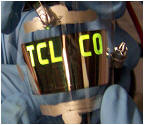One of the attractive advantages of OLED is the possibility of depositing organic films on flexible substrates. The use of thin flexible substrates will significantly reduce the weight of flat panel displays and provide the ability to conform, bend or roll a display into shapes. Moreover, it will open the possibility of fabricating displays by continuous roll processing, thus providing the basis for low-cost mass production. To date, some FOLEDs have been fabricated on flexible plastic substrates, but their performance is far from the requirement of display applications. Several problems must be solved before FOLEDs can become a reality. The extreme sensitivity of OLEDs to water and oxygen requires an extremely low gas permeability of the substrates that is far from what any known transparent polymeric substrate can achieve. Unlike OLED on rigid glass, the encapsulation for flexible OLED is neither rigid metal sheet or glass caps. Therefore, an advanced thin film encapsulation technique has to be developed. It generally consists of single layer or multi-layers of nano-scale organic and inorganic thin films, which act as a barrier to protect the electrode and active region from water and oxygen permeation.




